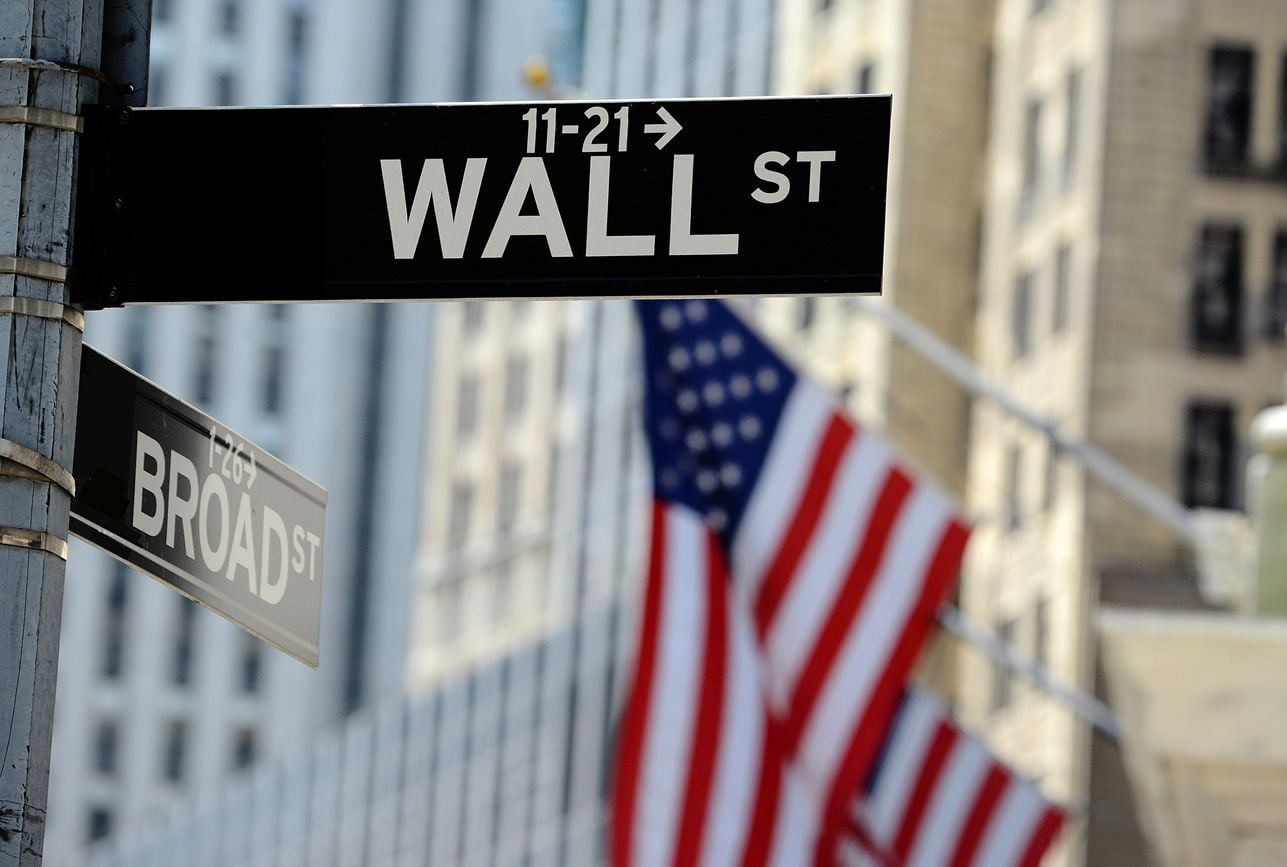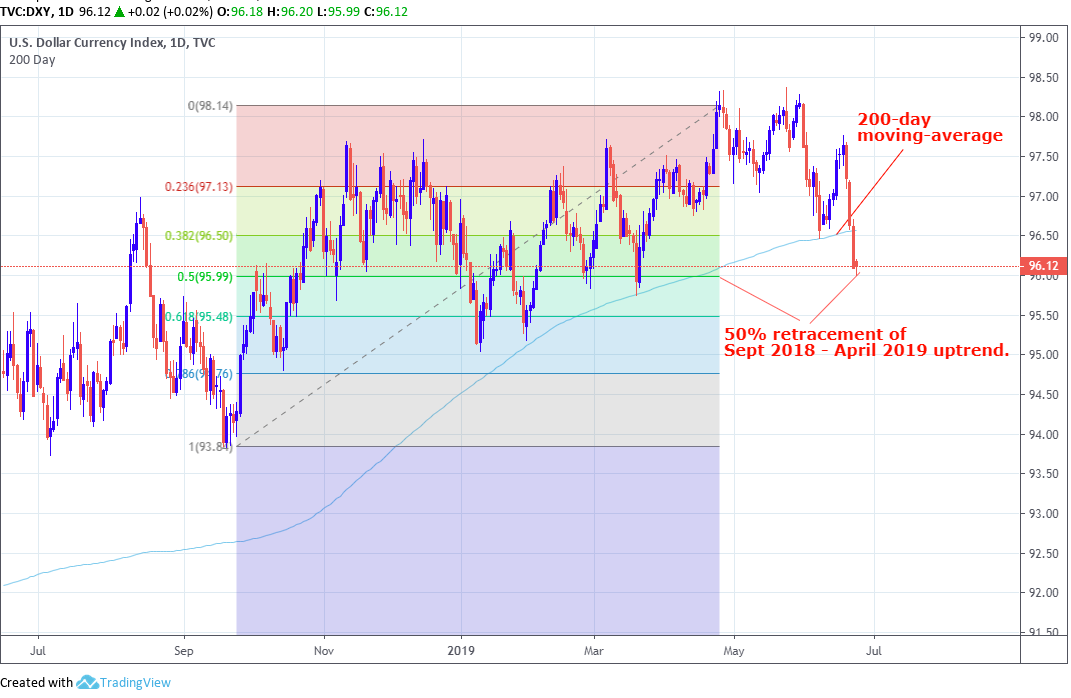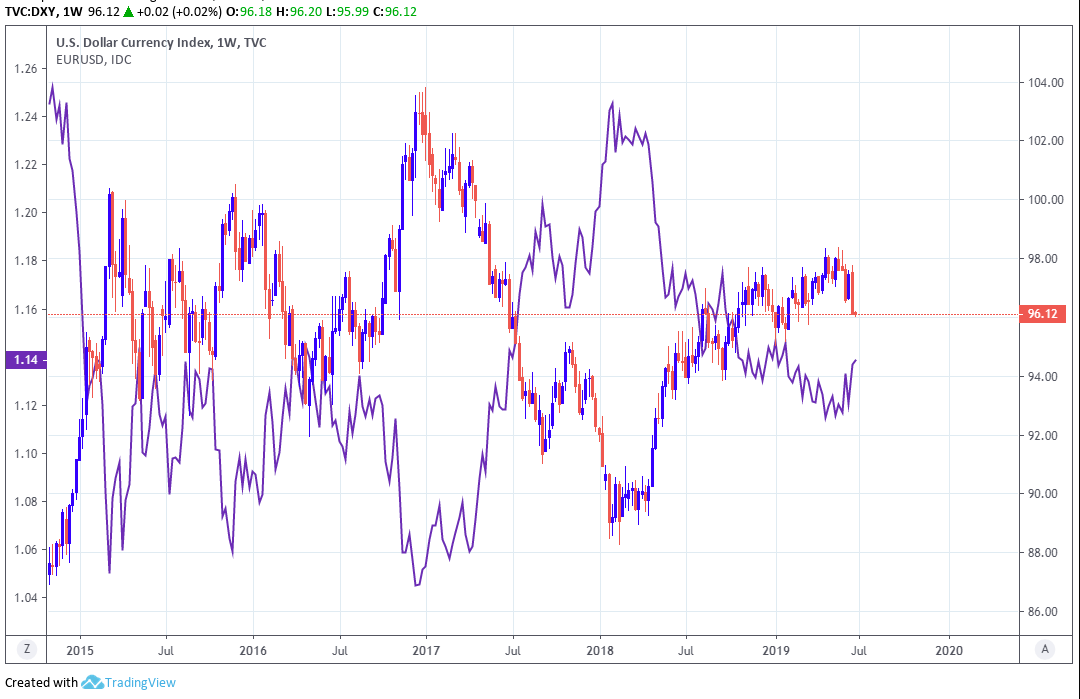Dollar Faces an "Accelerated Sell Off": MUFG
- Written by: James Skinner

Image © Adobe Images
- MUFG and Morgan Stanley say more USD losses on the way.
- Downward momentum to build now USD through key support.
- Fed retreat from rate hike the policy catalyst, economy in focus.
The Dollar was on course for its fourth consecutive day of losses on Monday after having broken below a key level of support on the charts, which analysts at MUFG and Morgan Stanley say could open the door to another leg lower by the U.S. currency over the coming days.
The Dollar index closed below the 96.50 level last Friday, which is significant because it was the location of the 200-day moving-average of prices. The index is now testing the 50% Fibonacci retracement of the September 2018-April 2019 uptrend, located around the 96.0 area.
Both of those levels are major thresholds as far as technical analysts studying trends and momentum on the charts are concerned. MUFG, the world's fifth largest bank and a significant foreign exchange dealer, says this means further losses are in the pipeline.
"The dollar index finally broke below its 200-day moving average on Friday at 96.600 which opens the door to further weakness in the near-term. Last week’s clear signal form the Fed that it is planning to cut rates as soon as at their next FOMC meeting in July is beginning to weigh more heavily," says Lee Hardman, a currency analyst at MUFG, in a note to clients.

Above: Dollar Index at daily intervals. Annotated for 200-day moving average and 50% retracement.
Hardman, who said last week that a "decisive break below" 96.50 would lead to an "accelerated U.S. Dollar sell off", now says his forecasts for the Dollar index will be revised lower in MUFG's July 'FX Outlook'.
This is in part because he and the MUFG team expect the Federal Reserve (Fed) to cut its interest three times before March 2020, which would mark a decisive end to the four-year interest rate hiking cycle that drove the Dollar index some 4% higher last year alone.
For its part the Fed itself has shifted from projecting one more rate hike before the end of 2020 to hinting that two rate cuts are now on the way, due mainly to fears about the health of the U.S. economy. The White House is also pushing for the bank to lower U.S. borrowing costs in order to keep the economic expansion going.
Fears for the economy are mounting because President Donald Trump's trade war with China, which escalated in May, is now likely to exacerbate a slowdown that had been in the cards for some months already. The economy was always likely to slow in 2019 after being pumped in 2018 by tax cuts.
"The dovish shift in Fed policy is increasing upward pressure on low yielding currencies such as the Swiss franc and yen," Hardman writes. "Evidence of a more marked and prolonged US slowdown will likely be required for the Fed to deliver a third rate cut in Q1 of next year. It could create an even more bearish outlook for the dollar."
President Donald Trump is threatening to impose a 25% tariff on the remaining $300bn of China's annual exports to the U.S. if his counterpart does not agree to sign up to a deal that Chinese negotiators previously backed out of.
He already lifted from 10% to 25% the tariff charged on $200 bn of China's exports back in May, after Chinese negotiators backed away from an agreement they'd spent some five months drafting with the U.S.
Surveys are now increasingly showing the U.S. manufacturing sector struggling as companies are forced to pay the 25% levies imposed on imported components and finished goods. And households are also contenting with the nine Federal Reserve interest rate hikes announced since late 2015.

Above: Dollar Index at weekly intervals, alongside EUR/USD rate. Illustrates negative correlation of two.
"The USD has not yet fully adjusted to the new structural dovish stance from the FOMC. The Fed has revised its estimate of the neutral policy rate, and more cuts may be in store than it has telegraphed," says Gek Teng Khoo, a strategist at Morgan Stanley. "A [Dollar Index] break below support at 96.50 suggests further downside momentum."
Khoo and the Morgan Stanley team have been bearish in their outlook for the U.S. greenback for some time now and are also looking for another leg lower in the Dollar index over the coming week.
The Dollar index is a broad measure of the U.S. currency's performance against key trading partner currencies including the Euro, Pound Sterling, Japanese Yen and Canadian Dollar among others.
However, if there's any one rival unit that's likely to gain most from this down move it would be Europe's single currency because the Euro-to-Dollar rate accounts for some 50% of the overall Dollar index. The Japanese Yen accounts for around 13.6% of the index while Pound Sterling has a weighting of 11.9%.
Time to move your money? Get 3-5% more currency than your bank would offer by using the services of foreign exchange specialists at RationalFX. A specialist broker can deliver you an exchange rate closer to the real market rate, thereby saving you substantial quantities of currency. Find out more here.
* Advertisement




